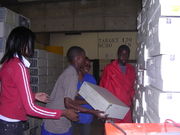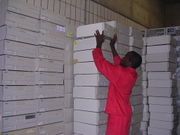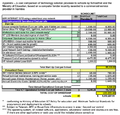The Case of SchoolNet Namibia/Operations/Activities/Procurement
Procurement
SchoolNet[1] relied heavily on donations of surplus computers and pro-actively searched for offers and approached organisations for used computers.
Examples:
- In 2004, Telecom Namibia “donated 139 redundant computers to SchoolNet Namibia, including 236 monitor screens, nine laptops, and 88 keyboards. The value of the donation is about N$112,400”[2].
- In February 2006 First National Bank (FNB) donated 700 “redundant” computers and monitors and shared the support costs with schools over a 3 - 5 year period[3].
Initially, SchoolNet would take anything they could lay hands on, confident that it would not be too much trouble for the the technical service centres to prepare the machines for deployment in school PC laboratories. Occasionally, “trick or treat” containers would arrive with a mix of machines requiring a lot of work, sometimes turning out to unusable in school labs. This led to SchoolNet Namibia becoming wiser about what to buy/accept.
SchoolNet continued to surf the internet for traders in second- hand computers from whom they could buy PCs for as little as US$45 per unit, which was about half the going rate among international donor agencies.
SchoolNet would only import the computer casings containing the central processing units and convert them into thin clients. New mice, keyboards, monitors and servers (one per lab. plus external modem) were sourced locally.
Technology changes, but SchoolNet managed to extend the life-times of computers in the labs through this thin client approach and use of free software, which is generally less resource-intense than equivalent non-free alternatives.
An article published in 2007[1] reports the hardware specifications for a typical lab. as follows:
- Thin clients: 5 - 20 x refurbished thin client diskless workstations
- each with a new monitor, mouse and keyboard
- Server: 1 x Pentium IV server computer
- UPS: 1 x uninterruptible power supply unit (UPS).
- Server software: GNU/Linux operating system
- Modem: x 1 attached to the server for dial-up connection to the internet
- Wireless: 1 x wireless transmitter/receiver for radio subscriber unit s (for wireless connectivity).
- LAN: 1 x 8-port Ethernet hub, Ethernet cabling
- Power cabling, extension chords, one five-plug adaptor, a conduit and
- Applications software and educational content.
The figures below illustrate the difference between SchoolNet's model of deployment and that of the commercial service provider hired by the Ministry of Education.
If the ministry decision makers had taken this model seriously, SchoolNet would have been able to provide technologies to schools significantly more economically than the commercial vendors used by the Ministry of Education instead of SchoolNet!
An issue which arose in relation to hardware procurement was that some international distributors would not recognise SchoolNet as a re-seller. They regarded SchoolNet as an end-user subject to higher pricing. For this reason, SchoolNet Namibia obtained computers via NetDay, a legally separate entity able to offer better prices on account of its low overheads.
NetDay had an important role to play in the early days (1999 – 2003/4) to secure realistic wholesale pricing from computer distributors in Namibia, South Africa and further afield. NetDay was a section 21 not for profit company registered with the Department of Trade and Industry as an ICT reseller. In those early days, it was effectively impossible for an NGO like SchoolNet to buy directly from a computer distributor in Namibia or South Africa, and rumours flew that local computer (retail) resellers threatened local distributors with loss of business if they did business with SchoolNet directly!
When companies like Game, Hi-Fi Corporation and Incredible Connection opened for business in Namibia, it was no longer an issue, since the prices then became far more competitive, and SchoolNet could do business with virtually anyone.
- ↑ 1.0 1.1 Sources include: Komen, J. (2007) Raising school standards . ICT Update, 38. http://ictupdate.cta.int (etc.)
- ↑ Corporate Social Responsibility Report , Telecom Namibia, 2004.
- ↑ http://www.schoolnet.na/news/stories/fnbdonateshundreds.html (retrieved 20/9/10)



